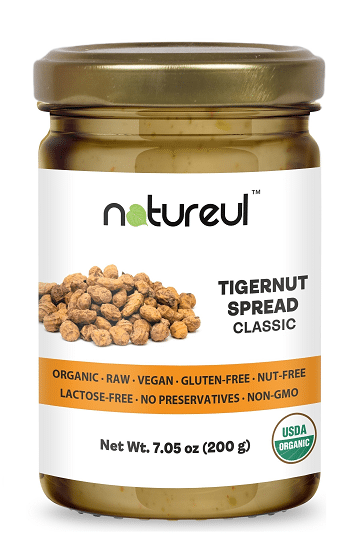Tigernut butter is rapidly growing in popularity as an alternative to peanut butter and other nut butters, but for some, there’s still a lot of mystery surrounding this snack spread. What is tigernut butter? What’s it made of? How does it taste? Where can you buy it? These questions may influence whether or not you’re open to trying this tasty, allergy-friendly spread for yourself.
Let’s dive into all things tigernut butter, starting with what tiger nuts are and where they come from. In this list, we’ll explore relevant information about tigernut butter including nutritional content, production, popularity, flavor, environmental impact, and allergen information.
Introduction
Tigernuts are a little tricky–despite their name, appearance, and flavor, they aren’t actually nuts. They’re actually yellow nutsedge, part of the sedge family from the Eastern Hemisphere. Tigernuts are nut-like tubers that grow under the ground and have a wrinkly casing or skin and a nutty flavor. They can be eaten whole when roasted, or they can be transformed into a myriad of products for a variety of culinary applications.
Tigernut butter is a spread that’s typically made from finely ground tigernuts, and edible oils. It can be used in place of traditional nut butters like peanut butter and almond butter in various applications, from spreading on breads and crackers to baking and snacking. Tigernut butter can sometimes contain added flavor or sweeteners, but it varies from brand to brand.
Nutritional Content
Tigernuts are packed with nutrients! They contain 18 amino acids (protein) that help build and maintain healthy muscles, joints, and skin. Tigernuts and tigernut products are also high in fiber, which can help with digestion and balancing blood sugar, and they contain key minerals (iron, magnesium, potassium, zinc) necessary for everyday processes in the human body. Tigernuts are high in monounsaturated fat, which is considered a heart-healthy form of fat.
Because tigernut butter doesn’t contain nuts or many common allergens, some brands (like Natureul) are more suitable to those with allergies than other nut butters. Tigernut butter has a lower protein content compared to peanut or almond butter, but it’s much higher in fiber.
Production Process
Tigernut butter is made by grinding up tigernuts to a fine, flour-like, powdery consistency (sometimes soaking and draining the nuts before grinding), then adding oils to create a smooth, spreadable plant-based butter. Optionally, spices, salt, sweeteners, and other flavorings can be added to alter the taste of the tigernut butter.
Most nut butters don’t require soaking the nut before grinding them up, but as mentioned above, some traditional tigernut butter recipes call for soaking the tigernuts before beginning the grinding process. The minimal addition of preservatives and flavorings or other ingredients also distinguishes tigernut butter from the like, but the simplicity of the recipe may be unique to each tigernut butter brand.
Flavor and Texture
Many folks that try tigernut butter say that it has a unique but familiar flavor. It tastes somewhat similar to other mild nut butters–a little earthy like you would expect from peanuts or walnuts combined with a mild natural sweetness. Some liken the mild sweetness to coconut flour. Tigernut butter can be sweetened further with the addition of natural sweeteners like agave nectar and dates or standard processed sugars like white cane sugar.
Tigernut butter is much smoother than other nut butters. It also has a slightly looser consistency compared to thicker options like almond butter and peanut butter, but can be thickened depending on the ratio of ground tigernuts to oil.
Allergen Information
Because tigernuts aren’t actually nuts, tigernut butter is a safe alternative for people with nut allergies! It can also be safe for those with dairy allergies and vegetarian or vegan dietary restrictions, depending on the brand used. Natureul, for example, is completely plant-based, gluten free, vegan and dairy free!
Cyperus esculentus allergies (the plant family that tigernuts belong to) are very rare, but they do exist. This type of allergy is much less common than nut allergies, though, which affects about one percent of Americans.
Popularity and Availability
Tigernut butter has grown in popularity in recent years as interest in allergen-friendly foods and plant-centric diets continues to increase. As consumers become more concerned about the ingredients in their favorite products, alternatives to traditional snacks–in this case, peanut or almond butter–see a spike in demand to fill the void left by products with less-than-ideal ingredients.
Spread made from tigernuts can usually be found in the nut butter section of your local supermarket, or you might find it in the specialty section. The easiest way to find and purchase tigernut butter is via the internet, where a simple search for tigernut butter will yield several purchase options as well as recipe ideas for making it at home for yourself.
Tigernut butter itself is on the up and up as information and availability of tigernuts spreads across the Western Hemisphere from Europe and North Africa.
Environmental and Agricultural Considerations
As far as cultivation and production are concerned, the farming, harvesting, and processing of tigernuts has no significant impacts on the environment, including soil, air, or water. Like other crops of the same nature, farmers can use more or less environmentally-conscious farming practices to reduce environmental damages. Overall, compared to traditional nuts like peanuts, almonds, and cashews, tigernuts have one of the lowest levels of carbon emissions when it comes to production and harvesting.
Just like many other crops, tigernut can be sustainably farmed by using ecologically friendly fertilizers. Tigernuts can also be farmed organically, which means they aren’t sprayed with heavy, toxic commercial pesticides or herbicides.
Conclusion
Though not technically a nut, tigernuts (and therefore, tigernut butter) can be a healthy addition to your diet, thanks to their constitution of protein, fiber, vitamins, and minerals. Tigernut butter is a safe alternative spread for those that have nut allergies, those with autoimmune conditions, and vegans or vegetarians. It comes in a variety of flavors and has relatively few ingredients compared to the leading brands of “traditional” nut butters. Try tigernut butter for yourself–it might just become your new favorite!





